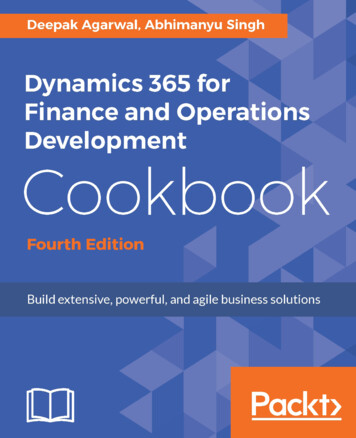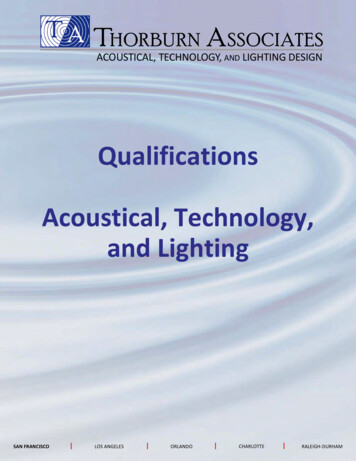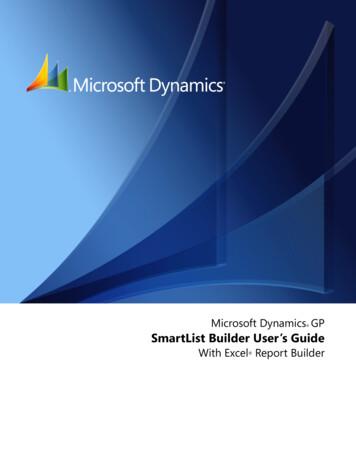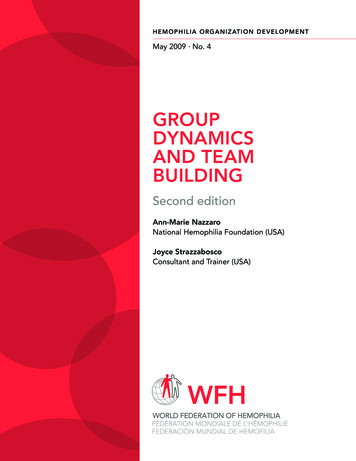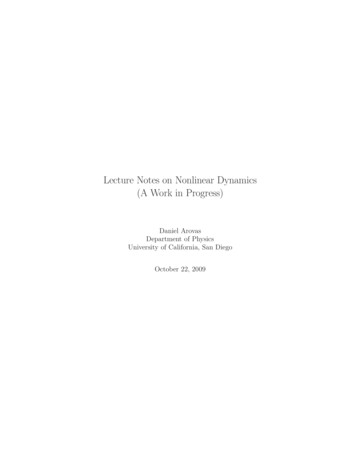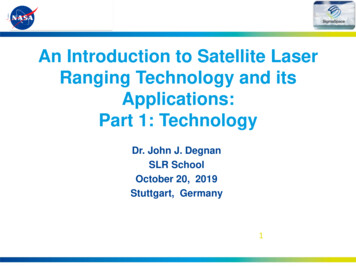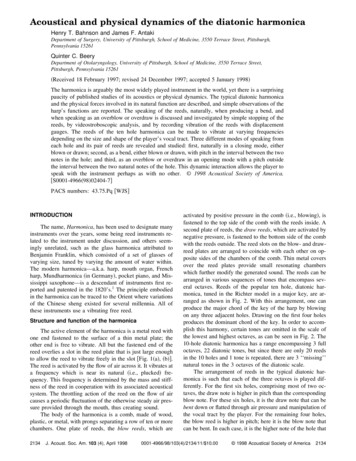
Transcription
Acoustical and physical dynamics of the diatonic harmonicaHenry T. Bahnson and James F. AntakiDepartment of Surgery, University of Pittsburgh, School of Medicine, 3550 Terrace Street, Pittsburgh,Pennsylvania 15261Quinter C. BeeryDepartment of Otolaryngology, University of Pittsburgh, School of Medicine, 3550 Terrace Street,Pittsburgh, Pennsylvania 15261 Received 18 February 1997; revised 24 December 1997; accepted 5 January 1998!The harmonica is arguably the most widely played instrument in the world, yet there is a surprisingpaucity of published studies of its acoustics or physical dynamics. The typical diatonic harmonicaand the physical forces involved in its natural function are described, and simple observations of theharp’s functions are reported. The speaking of the reeds, naturally, when producing a bend, andwhen speaking as an overblow or overdraw is discussed and investigated by simple stopping of thereeds, by videostroboscopic analysis, and by recording vibration of the reeds with displacementgauges. The reeds of the ten hole harmonica can be made to vibrate at varying frequenciesdepending on the size and shape of the player’s vocal tract. Three different modes of speaking fromeach hole and its pair of reeds are revealed and studied: first, naturally in a closing mode, eitherblown or drawn; second, as a bend, either blown or drawn, with pitch in the interval between the twonotes in the hole; and third, as an overblow or overdraw in an opening mode with a pitch outsidethe interval between the two natural notes of the hole. This dynamic interaction allows the player tospeak with the instrument perhaps as with no other. 1998 Acoustical Society of America.@S0001-4966 98!02404-7#PACS numbers: 43.75.Pq @WJS#INTRODUCTIONThe name, Harmonica, has been used to designate manyinstruments over the years, some being reed instruments related to the instrument under discussion, and others seemingly unrelated, such as the glass harmonica attributed toBenjamin Franklin, which consisted of a set of glasses ofvarying size, tuned by varying the amount of water within.The modern harmonica—a.k.a. harp, mouth organ, Frenchharp, Mundharmonica in Germany!, pocket piano, and Mississippi saxophone—is a descendant of instruments first reported and patented in the 1820’s.1 The principle embodiedin the harmonica can be traced to the Orient where variationsof the Chinese sheng existed for several millennia. All ofthese instruments use a vibrating free reed.Structure and function of the harmonicaThe active element of the harmonica is a metal reed withone end fastened to the surface of a thin metal plate; theother end is free to vibrate. All but the fastened end of thereed overlies a slot in the reed plate that is just large enoughto allow the reed to vibrate freely in the slot @Fig. 1 a!, b!#.The reed is activated by the flow of air across it. It vibrates ata frequency which is near its natural i.e., plucked! frequency. This frequency is determined by the mass and stiffness of the reed in cooperation with its associated acousticalsystem. The throttling action of the reed on the flow of aircauses a periodic fluctuation of the otherwise steady air pressure provided through the mouth, thus creating sound.The body of the harmonica is a comb, made of wood,plastic, or metal, with prongs separating a row of ten or morechambers. One plate of reeds, the blow reeds, which are2134J. Acoust. Soc. Am. 103 (4), April 1998activated by positive pressure in the comb i.e., blowing!, isfastened to the top side of the comb with the reeds inside. Asecond plate of reeds, the draw reeds, which are activated bynegative pressure, is fastened to the bottom side of the combwith the reeds outside. The reed slots on the blow- and drawreed plates are arranged to coincide with each other on opposite sides of the chambers of the comb. Thin metal coversover the reed plates provide small resonating chamberswhich further modify the generated sound. The reeds can bearranged in various sequences of tones that encompass several octaves. Reeds of the popular ten hole, diatonic harmonica, tuned in the Richter model in a major key, are arranged as shown in Fig. 2. With this arrangement, one canproduce the major chord of the key of the harp by blowingon any three adjacent holes. Drawing on the first four holesproduces the dominant chord of the key. In order to accomplish this harmony, certain tones are omitted in the scale ofthe lowest and highest octaves, as can be seen in Fig. 2. The10-hole diatonic harmonica has a range encompassing 3 fulloctaves, 22 diatonic tones, but since there are only 20 reedsin the 10 holes and 1 tone is repeated, there are 3 ‘‘missing’’natural tones in the 3 octaves of the diatonic scale.The arrangement of reeds in the typical diatonic harmonica is such that each of the three octaves is played differently. For the first six holes, comprising most of two octaves, the draw note is higher in pitch than the correspondingblow note. For these six holes, it is the draw note that can bebent down or flatted through air pressure and manipulation ofthe vocal tract by the player. For the remaining four holes,the blow reed is higher in pitch; here it is the blow note thatcan be bent. In each case, it is the higher note of the hole that0001-4966/98/103(4)/2134/11/ 10.00 1998 Acoustical Society of America2134
FIG. 1. a! Exploded view of the ten hole diatonic harmonica showing theupper, blow reed plate, the lower, draw reed plate and the separating comb.Upper and lower covers of the reed plates are not shown. Reeds are mountedon the inside surface of the blow reed plate and the outside of the draw reedplate. Thus blowing closes the blow reed into the blow reed plate and opensthe draw reed out of the draw reed plate. The reverse occurs on drawing. Itis the closing reed that speaks on natural playing. b! Schematic, crosssectional view of reeds and plates of a hole of a diatonic harmonica. Reedsvibrate in slots cut out of the reed plate. Blowing into the hole closes theblow reed and opens the draw reed. Drawing closes the draw reed and opensthe blow reed.FIG. 2. Notes and approximate frequencies of a ten hole, diatonic harmonica, key of C. The upward arrow indicates blow; the downward arrow,draw. Blow and draw bends are indicated by bent shafts, up and down,respectively; number of semitones bent is indicated by number of arrowheads. Overblow and overdraw are indicated by slashed arrows.2135J. Acoust. Soc. Am., Vol. 103, No. 4, April 1998appears to be bendable, whether blown or drawn. The oftenstated rule is that one can bend the pitch of the higher note ina hole down to a semitone above the lower note of the respective hole. It should be pointed out that bending producesvirtually continuous pitch control within the interval betweenthe blow and draw notes of the hole, in contrast to overblowing, to be discussed later.In order to play the basic, natural tones of the key of theharp, no special configuration of the vocal tract is typicallyrequired. The player simply blows or draws through the appropriate hole. Vibration of the reeds occurs as a result of theinteraction of aerodynamic forces acting on the reed and themechanical properties of the reed itself. It is well known thata plucked reed will oscillate at a natural frequency determined by its mass distribution and stiffness. In order to causeself-sustaining oscillations, air must flow past the reed in amanner which reinforces this vibration. St. Hilaire et al.2have shown that such pressure instabilities could result whenair flow is sufficient to cause boundary layer separation at theedge of the reed surface. When this occurs, the aerodynamicdrag force on the reed increases as the gap decreases, and thereed moves against the air flow. Conversely, the drag forcedecreases when the gap increases, and the reed moves withthe flow. This will thus inject energy into the reed motion,giving it a ‘‘kick.’’ This phenomenon can also be describedin terms of acoustical impedance, as outlined by Johnston.3The resulting frequency of oscillation will differ from theplucked frequency because of the coupling with the acoustical inertance and compliance of the air flow and airway ofthe player.A reed vibrating in this fashion with the reed attached tothe high pressure side of the reed plate and being forcedprimarily into the reed plate is said to function as a closingreed. Simultaneously the companion reed, overlying thesame cavity but attached to the outer, low pressure side of itsreed plate, is blown open. It vibrates only minimally whenthe natural note is played and functions as an opening reed.Consequently, the frequency of vibration of the opening reedis determined primarily by the closing reed. When the playerblows through a hole, the blow reed is a closing reed, and thedraw reed is an opening reed. When the player draws on thehole, these actions are reversed. Alternatively, one can definethe blow reed as the reed which speaks primarily when theplayer blows through a given hole. The reverse occurs ondrawing. The primary speaking reed is the closing reed ineach case of simple blow and draw. It is worth pointing outthat despite the names, opening and closing, both reeds do infact open and close their respective reed slots in the course oftheir vibration. Accordingly, this nomenclature conventionunfortunately introduces some confusion. However, inasmuch as this designation is well established, we will adoptthis terminology to designate the mode of operation of aparticular reed.!The discovery that missing notes of the diatonic scaleand some notes of the chromatic scale can be fashioned bybending is attributed to the African-Americans of the southern United States in the last half of the nineteenth century.Modern instructions on this technique have been describedas: ‘‘.draw in sharply, drop the jaw a bit, along with theBahnson et al.: Harmonica—Physiology, physics, and phonetics2135
studies elaborate on Baker’s observations and couple thesewith Johnston’s theoretical examination of the physical dynamics of harmonica reeds.I. FUNCTION OF HARMONICA REEDSA. Preliminary observationsFIG. 3. Cross section of the vocal tract.tongue, causing the air to dart downward to the floor of themouth;’’4 ‘‘.suck the air through the harp towards the tip of@the# tongue;’’5 ‘‘@inhale# with more force and @cause# the airstream to move to the bottom of the mouth and throat;’’6 or,most descriptively, ‘‘@take# in air from your shoe.’’7 Glover8instructs that if one visualizes drawing a column of air, like astraw, over the tongue and throat, then bending consists of‘‘bending that column of air down to the front part of @the#lower jaw.’’ Palmer9 relates that Sonny Terry’s techniquewas: ‘‘If you constrict the flow at any point along its passagefrom reeds to lungs, you change the resultant pitch of thereeds. Most harpmen choke the harp to achieve this effect.They narrow the opening in their throats to constrict the airflow.there is a simultaneous increase in pressure from thelungs.’’ Most practical is the advice of Baker,10 ‘‘.thetongue and throat movements when bending notes is analogous to! different vowel sounds,. like forming AAH toOOH,. or EEE to OOO for the high notes.’’ We interpretthese instructions as attempts to describe alterations of thevolume and configuration of the vocal tract—here used todescribe the lips, cheeks, mouth, pharynx, and trachea Fig.3!. Unfortunately for the novice, the oropharyngeal configurations required in bending are not identical to any of thoseof normal speech.There is an unfortunate dearth of reports in the scientificliterature about the acoustics of the harmonica, or the physiology involved in playing it. Perhaps this is due to its humblenature, for there are many reports, and indeed volumes, onmore ‘‘noble’’ instruments. In the nearly unique article concerning physics of the harmonica by Johnston,3 all of thereferences cited are to observations on other instruments,mostly woodwind and reed instruments. He cites no references to previous studies of the harmonica. Subsequent toJohnston’s article, in the second edition of Harp Handbook,1991,10 Steve Baker described his experience based onsimple observations and logical deductions, but his description lacks the benefit of vigorous scientific procedure. Our2136J. Acoust. Soc. Am., Vol. 103, No. 4, April 1998Key to most of the expression on the harmonica is theability of the musician to play a single note. Pursing the lipsto the size of a single hole is the commonly used technique.Tongue blocking is another technique in which the lips coverseveral holes but the tongue blocks one or more of theseholes. The player forces air through a hole on one or bothsides of the tongue. Another method, curling the tip of thetongue into a tube that surrounds the hole, limits use of thetongue for other purposes, such as tongue blocking for octaves. However, curling the tongue permits playing with thecovers of the harmonica removed. Consequently, the curledtongue technique was used in several of our studies. By suchplaying with the covers off and alternately stopping one orthe other reed with a finger, one learns that stopping the drawreed while blowing has no effect on pitch and only a slightincrease in loudness of the blown tone. This is most noticeable with more vigorous playing. The findings are reversedon drawing and stopping the blow reed. This suggests thatstopping the reed that is not primarily speaking decreases theleak of air from the chamber, and that the natural blow anddraw tones come predominantly from the blow and drawreeds, respectively. The other reed of the hole contributesminimally if at all.As mentioned above, the technique of bending notes isperceived as a lowering of pitch as the player appropriatelyalters the vocal tract. Draw bends are obtained in the lowerholes 1 through 6 where the higher pitched tone is drawn,and blow bends are obtained in holes 7 through 10 where thehigher pitched tone is blown. Alterations of the vocal tractinvolved in bending tones principally consists of archingand/or thickening the tongue at various places along itslength anterior or posterior!. This has the effect of alteringthe volume and shape of the resonant cavity.So-called overblow and overdraw tones are a relativelyrecent addition to playing. Such tones can be elicited from allholes of the diatonically tuned harmonica cf. Fig. 2!, butthey are used for holes 1, 4, 5, and 6 blow and 7, 9, and 10draw to produce notes that are otherwise missing on the diatonic harmonica a flatted third—holes 1 and 4 blow; asharped fourth and a flatted seventh—holes 5 and 6 blow; aflatted second—holes, 7 and 10 draw; and a flatted sixth—hole 9 draw!. Stringent control of breath and positioning ofthe player’s vocal tract are required in order to play overblowand overdraw tones. The novice attempting to play overblowtones can be very rapidly frustrated, for the consequence ofan incorrect posture of the vocal tract is either silence, or aninharmonious sound. The first recording of such a tone iscredited to Blues Birdhead James Simons! in 1929,11 butfull use and perfection of the tones awaited the skill andpersistence of Howard Levy who plays them with as muchfacility as he plays the bends. Consequently he is able to usethe naturally diatonic harmonica as a fully chromatic instruBahnson et al.: Harmonica—Physiology, physics, and phonetics2136
FIG. 4. Tones that can be modulated from blow and draw reeds together andalone on a Golden Melody Harmonica Hohner! key of C, observed byblocking reeds with a finger. 1! and 2! indicate cents above or below thenotes indicated along the abscissa. s is blow note, d is draw note. Symbolsotherwise are as in Fig. 2. Bars indicate range of frequency obtained bybending: black, straight with both reeds free; light gray, blow and drawbends with draw reed alone with blow reed blocked; dark gray lowermostof the 3 bars!, draw reed alone with blow reed blocked. Bars on holes 1–6indicate draw bends, and on 7–10 blow bends. A more skillful player mightincrease the ranges with more precise configuration of the vocal tract. Notethat both reeds are usually active with bends. Pure overblow and overdrawtones are obtained from a single reed see overblows and overdraws forholes 1, 4, 5, 6, 7, and 9!. Note that in holes 1 to 6 the draw note is higherpitched than the blow note, and bends are drawn. In notes 7 to 10 the reverseis true, i.e. the blow note is higher pitched than the draw note, and bends areblown rather than drawn.ment. The resulting musical effects that this enables can bequite extraordinary.The preliminary qualitative observations of reed motionwith the covers off prompted a more rigorous investigationof reed and function. This was accomplished by three techniques: analysis of pitch production, videostroboscopic observation, and precision, noncontacting measurement of thedisplacement of the reeds.B. Pitch production and reed primacyFigure 4 illustrates the range of pitch that can be obtained from each hole of the diatonic harmonica as it is usually played, i.e., draw bending holes 1 to 6 and blow bendingholes 7 to 10. The pitch was determined with a digital tuner Korg, DT-2, Tokyo! and is expressed as cents above orbelow the targeted pitch. It is convenient to refer to harmonica reeds as functioning primarily and secondarily, because although actions of the blow and draw reeds are re2137J. Acoust. Soc. Am., Vol. 103, No. 4, April 1998lated, one reed usually dominates and is the speaking reed.Some simple initial studies were conducted to identify reedprimacy by alternate blocking of one or the other of the tworeeds of the hole while playing various notes—straight, bent,and overblown. Figure 4 also illustrates the range of pitchthat can be obtained from each reed when the opposing reedof the hole is blocked. Within certain limits both reeds of agiven hole can be induced to vibrate over a range of frequencies between the natural frequencies of the two reeds of agiven hole.When the blow and draw notes in the hole are two semitones apart, for example hole 4, the bent tone can be obtainedfrom either reed with the proper configuration of the vocaltract. This suggests that the bent tone normally comes fromeither or both reeds, and that the reeds can be made to shareprimacy in producing the bent tones. When the tones in thehole are four semitones apart as in hole 3, the higher pitchedreed whether blow or draw! is primary for the first portionof the bend and lowering of pitch one semitone. When thefull, three-semitone bend is obtained, however, the sound isproduced entirely from the lower pitched reed which becomes primary. More specifically, the first semitone, drawbend of hole 3 B flat on a C harp! is produced primarilyfrom the draw reed. The second semitone, A, can be produced from either reed alone and is most easily produced byboth together. The third semitone bend, A flat, comes fromthe lower pitched blow reed. Similar reed function is foundin holes two and ten where the notes are three semitonesapart. In hole 10 the bend is a blow bend.!The rule that one can bend the tone of a reed down to asemitone above the lower note in the hole is a convenientone for the player since that is what appears to happen. To bemore accurate, however, one should recognize that primacyshifts to the lower pitched reed which is modulated up. Thusbends more properly must also be considered as involving anupward as well as downward modulation of pitch. Furthermore, when the higher pitched reed is blocked, it is possibleto bend the lower pitched reed down. When the higherpitched reed is unblocked during one of these bends, the bentnote is rapidly squelched.Greater skill in bending allows wider range of control ofall modes of reed action. A more skillful player might extendthe range of bending beyond those shown in Fig. 4, as wellmight one do with a differently configured or tuned harp.Nonetheless, it appears that whether bending a tone up ordown with both reeds free, the pitch can be bent most easilyin the direction of the other note in the hole and is muchmore difficult if not impossible! when the lower pitchedreed is blocked.In summary of these observations of reed function, itappears that both draw and blow bends involve both reeds toproduce pitches in the interval between the natural pitches ofthe two reeds. The higher pitched reed bends down and thelower pitched reed bends up. The bent tone seems to comeprimarily from the reed with the natural pitch closest to thetone being played. There is more overlapping function of thelower pitched reeds, as in hole 3, than in the higher ones, asin hole 9. These conclusions require more quantitative validation. Accordingly, the speculation and subjectivity associBahnson et al.: Harmonica—Physiology, physics, and phonetics2137
TABLE I. Stroboscopic examination of blow and draw reeds with variousmodes of playing. 111! indicates vigorous action; 11! is moderateaction, and 1! is minimal action. D Bend, DD Bend, and TD Bend indicatea draw bend, double draw bend, and triple draw bend respectively.HoleActionAppx.noteBlow reedDraw reed1BlowDrawD BendOverblowCDC#D#11111111011111112BlowDrawD BendDD BendEGF#F111011110111111113BlowDrawD BendDD BendTD BendOverblowGBA#AG#C1101111100111111111 to 11114BlowDrawD EFF#1111111116BlowDrawD BendOverblowGAG#A#111011100111011110. Somewhat similar observations were reported independently by Thaden,13 Baker,10 and other observant players.14Overblows and overdraws are examples of things notbeing exactly what they seem on the harmonica. It would belogical to think, and was commonly believed, that the overblow notes come from the blow reed on which the player isblowing and that the pitch jumps up two or three semitonesas one continues to blow. In actual fact, our simple, initialstudies of reed blocking with a finger showed that the overblow tone actually comes from the draw reed of the holewhich abruptly begins to vibrate as an opening reed, with apitch that is only a semitone higher than the draw reed’snatural frequency. Conversely, an overdraw tone was observed to come from the blow reed of the hole. In addition,stroboscopic analysis of the reeds during overblows showedthat the blow reed becomes almost still, in spite of intensifiedvibration of the draw reed. Stopping the blow reed whileplaying an overblow tone also makes the tone purer, louder,and easier to hit. This observation led to the development ofa modification of the typical diatonic harp that makes it easily fully chromatic.14,15 The pitch of both overblow and overdraw tones is outside the interval between natural pitches ofthe blow and draw notes of the hole, in contrast to bendswhich are almost completely within these intervals. Hence,there appear to be three modes of useful function of eachreed: closing as in the natural modes of simple blow or draw,opening as in bending with the pitch within the interval ofthe two tones, and an overblow or overdraw as an openingreed with a pitch above that interval.D. Reed primacy by dynamic vibration measurementsated with these preliminary observations that anyone canmake can be elucidated by measurement of reed dynamics.C. Stroboscopic evaluation of reed primacyThe above observations, obtained by blocking reeds,were confirmed by direct observation and by video recordingthe reed motion through a magnifying fiberoptic videoendoscope having a 70 angled tip Nagashima! under stroboscopic illumination Bruel and Kjaer, Rhinolarynx stroboscope, 4914!. When the frequency of the strobe was offsetslightly from the frequency of the tone being played, reedactivity could be observed as a slow motion portrayal of itsmovement.12 Analysis of the video tape recordings of suchstudies, summarized in Table I, shows that with simple blowand draw, the designated blow or draw reed vibrates freelywhile the secondary reed barely moves or vibrates minimally, the displacement being estimated at a twentieth or lessthat of the primary reed. At the beginning of a draw bend,the draw reed was observed to vibrate primarily, but as thetone dropped a whole tone or more, the blow reed began tovibrate and to become primary, even though the air flowcontinued to be drawn. In this mode, the blow reed functioned as an opening reed. Comparable observations weremade with the blow bends. These shifts in reed primacy weremost clearly seen in holes where the pitches of the blow anddraw tones are more widely separated, as in holes 2 and 3 or2138J. Acoust. Soc. Am., Vol. 103, No. 4, April 1998Dynamic measurements of reed vibration were performed to better quantify the observations obtained from theabove stroboscopic evaluation. These experiments were conducted with a Hohner Golden Melody harmonica with coversremoved, key of C, upon which were mounted two precision,noncontacting, proximity sensors KD-2400, Kaman Instruments Corp., Colorado Springs!, one over the blow reed andone over the draw reed. A specially constructed fixture allowed these sensors to be positioned to measure simultaneously the motion displacement! of both the blow anddraw reeds of any hole @see Fig. 5 a!#. The frequency response of the system was flat from DC to 10 kHz 63 dB!.The output of the reed displacement transducers was recorded digitally at 10 000 Hz by a computer workstation Apollo 3500, Apollo Computer Inc., Chelmsford, MA!which implemented high-speed data acquisition software Significat, Hudson, MA!. These signals were further processed in real time by a custom built circuit which measuredthe frequency and peak-to-peak amplitude of both signals ofreed displacement. The latter data were recorded on a PC/386 with commercial acquisition software LabTech Notebook, Laboratory Technologies, Inc., Wilmington, MA!.In addition to observations with simple oral playing, aresonating volume chamber was placed in the air stream adjacent to the harp @see Fig. 5 b!#. This device acted as arudimentary equivalent of the vocal passage, similar to asystem described by Johnston.3 With the simple plunger thevolume of the resonating chamber was easily altered, and theBahnson et al.: Harmonica—Physiology, physics, and phonetics2138
FIG. 5. a! Schematic of experimental apparatus for measuring and recording reed displacement. b! Sketch of variable resonating volume chamber 60-cc syringe! used to crudely simulate vocal tract, modified from devicedescribed by Johnston Ref. 10!.reeds were made to vibrate in any of the three differentmodes of speaking blow and draw; blow and draw bend;and overblow and overdraw! using regulated air pressureavailable in the laboratory.Raw displacement data were displayed in compressedform in order to reveal the relative displacement envelope ofthe two reeds during various maneuvers for example, seeFigs. 7 and 12!. The uncompressed display of the same dataallowed detailed analysis of the shape of the trajectory of theindividual reed displacement. The relationship between relative amplitudes and frequencies of the two reeds could beobserved during bends and overtones from the real time display of the signal processor circuit.Measurement and display of reed vibration providedseveral qualitative observations as well as quantitative results. Although all 10 holes were studied, we present belowdetailed results for hole 3, which were taken to represent thegeneral behavior observed for the remaining holes. It shouldbe noted, however, that the two reeds of hole 3 provide awider interval of tones than any other hole six semitonesfrom G, a straight note, to C, an overblow!. Although unique,the hole appears to encompass all modes of action.When a natural note was obtained by either blowing or2139J. Acoust. Soc. Am., Vol. 103, No. 4, April 1998FIG. 6. a!, b! Reed displacement with time for straight blow a! and draw b! notes on hole 3. Reeds move in parallel. Displacement values are relativeonly.drawing, only the primarily speaking blow or draw reed wassignificantly active. There was only a minimal amount of thesecondary reed vibration @Fig. 6 a!, b!#. This confirmed theobservations made with the strobe light listed in Table I. Inaddition to the peak-to-peak amplitude of vibration, it wasalso informative to consider the relative displacement of thenominal position of the vibrating reed.When playing a low blow note @such as 3-hole blow,Fig. 6 a!#, the nominal, or ‘‘average,’’ position of the blowreed moved away from the comb. In other words, the blowreed appeared to travel farther upward, into the reed slot, outof the comb, than downward. The draw reed, although nearlyidle during blowing, appeared to displace slightly upward,into its respective reed slot and into the comb. The low drawnotes @such as 3-hole draw, Fig. 6 b!# were characterized bya primarily closing draw reed, but the blow reed appeared tovibrate, albeit slightly, either about the nominal position orslightly away from the comb. The high blow and draw notesBahnson et al.: Harmonica—Physiology, physics, and phonetics2139
FIG. 7. Relative displacement of blow and draw reeds entering a bend onhole 2, from G to approximately F#. Note, the draw reed speaks initially andas a closing reed, but the blow reed takes over as an opening reed, as theplayer continues to draw but with a different embouchure.behaved similarly, with roles reversed. These observationscontradicted the intuitive prediction that the nominal positionof both reeds of a hole should move outward on blowingwith positive pressure in the hole and inward on drawingwith negative pressure in the hole.Intuition would likewise dictate that the relative phasebetween the two reeds would result in their contrary motion:outward with blowing and positive pressure in the hole andinward with drawing and negative pressure in the hole. However, this was observed to be the case only for the high blownote
Modern instructions on this technique have been described as: ‘‘.draw in sharply, drop the jaw a bit, along with the FIG. 1. a! Exploded view of the ten hole diatonic harmonica showing the upper, blow reed plate, the lower, draw reed plate and the separating comb. Upper and lower c
